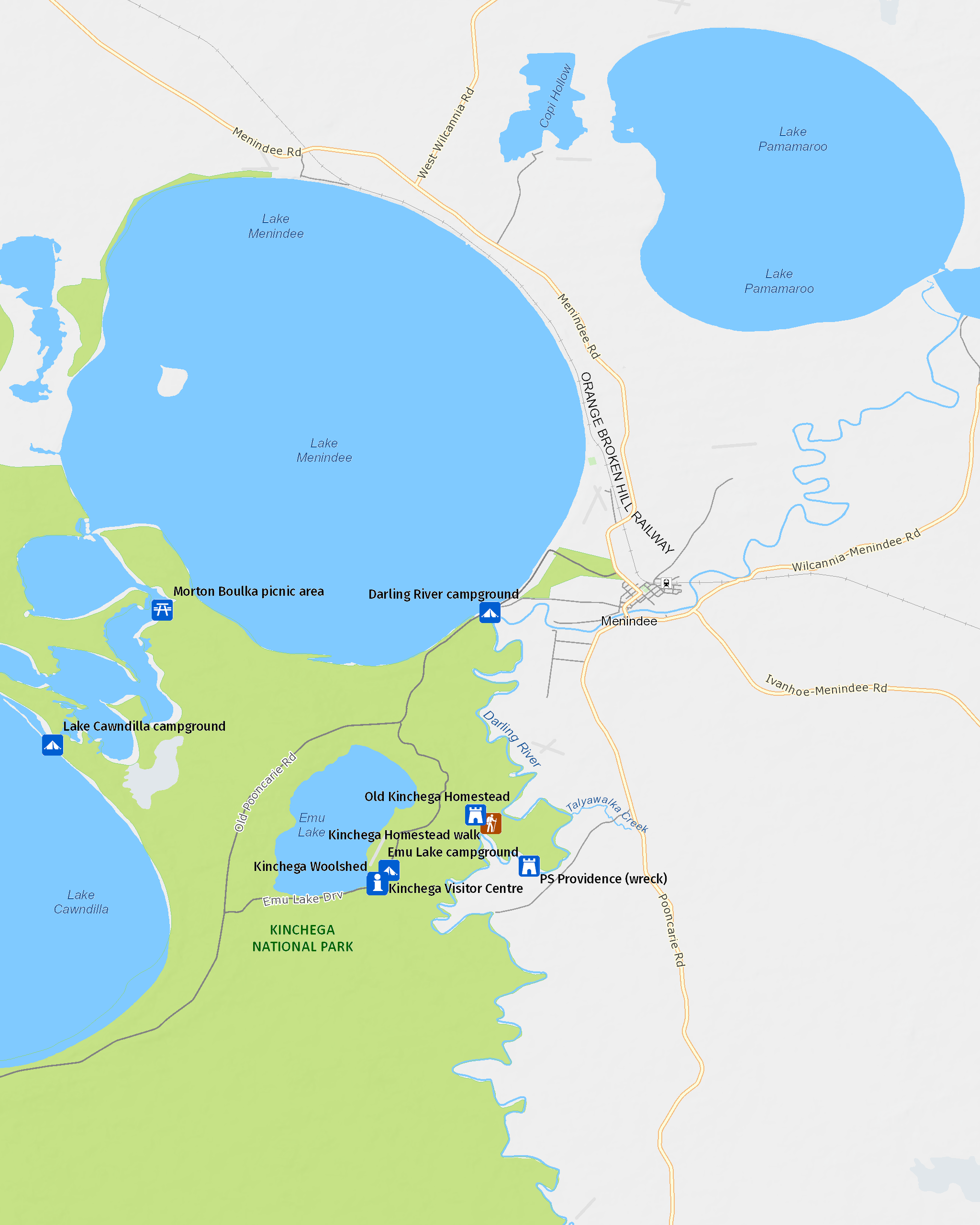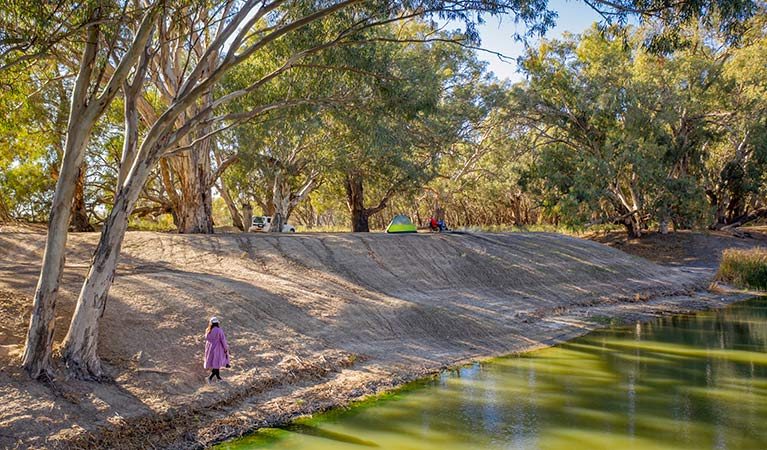Darling River campground
Kinchega National Park
Overview
Outback camping beside the Darling River in Kinchega National Park offers excellent birdwatching, barbecue facilities and swimming.
| Number of campsites | 34 |
|---|---|
| Camping type | Tent, Camper trailer site, Caravan site, Camping beside my vehicle |
| Facilities | Picnic tables, barbecue facilities, carpark, toilets |
| What to bring | Drinking water, cooking water, firewood |
| Entry fees | Park entry fees apply |
| Bookings | Book up to 12 people or 2 sites online. |
| Group bookings | School groups and Park Eco Pass holders can make a group booking enquiry. |
| Please note |
|
If you like to wake up to water views, then pitch your tent at Darling River campground. The picturesque Darling River, on the eastern edge of Kinchega National Park, is famous for birdwatching, wildlife and stunning wildflower displays.
As you set up camp, take a moment to soak in the tranquil vibe of this idyllic riverside campground but don’t be fooled; it’s bursting with life. Flocks of pink and black cockatoos nest in tree hollows whilst egrets and black kites patrol the waters. Not to be outdone, cheeky little finches hop through the scrub.
After a day exploring, cool off with a swim in the river before preparing a barbecue feast. On a warm night you might hear the mocking call of a perons tree frog, which sounds like laughter or a creaky door. Tumble into your sleeping bag to be soothed to sleep by the sound of the river flowing past.
Map

Map legend

Local alerts
For the latest updates on fires, closures and other alerts in this area, see https://www.nationalparks.nsw.gov.au/camping-and-accommodation/campgrounds/darling-river-campground/local-alerts
Bookings
- National Parks Contact Centre
- 7am to 7pm daily
- 1300 072 757 (13000 PARKS) for the cost of a local call within Australia excluding mobiles
- parks.info@environment.nsw.gov.au
Operated by
- Broken Hill office
- Monday to Friday, 8.30am to 4.30pm. Closed 1pm to 2pm.
- 08 8084 2880
- npws.westdarling@environment.nsw.gov.au
- 183 Argent Street, Broken Hill NSW 2880
Park info
- in Kinchega National Park in the Outback NSW region
Kinchega National Park is always open but may have to close at times due to poor weather or fire danger.
-
Park entry fees:
$8 per vehicle per day. The park has a pay and display envelope payment system - please bring correct coins.
Buy annual pass.
Visitor info
All the practical information you need to know about Darling River campground.
Maps and downloads
Visitor centre
-
Kinchega Visitor Centre
673 Woolshed Drive, Menindee NSW 2879 - Kinchega Visitor Centre is always open but it's unstaffed (self service)
Learn more
Darling River campground is in Kinchega National Park. Here are just some of the reasons why this park is special:
Aboriginal cultural heritage

This is the traditional land of the Paakantji nation who came together to share the bounty of the flood. These river people caught fish by spearing from a canoe or while diving and used nets and fish traps made from baskets. Artefacts and special sites in the area date back an incredible 35,000 years. Many of the staff at Kinchega are of Aboriginal descent and can provide a wealth of information and knowledge about the area. You could also participate in a Discovery tour to find out more about the Aboriginal culture and history of the park.
- Games and fun activities at Kinchega This is a program of fun games and activities we can play together in Kinchega National Park or Discovery rangers can visit your school. Designed for Stage 2 (Years 3-4) students with a focus on History, Geography and science, choose from some of these games: the Aboriginal site game, tracks and traces, Barkindji bush foods or the threatened species game.
- Kinchega Visitor Centre Find useful tourist information at Kinchega Visitor Centre. Get details on birdwatching and touring the Darling River and Menindee Lakes near Broken Hill in outback NSW.
Life in all its splendour

Lace monitors patrol the banks when it's warm, the Peron's tree frog sends out a call like laughter in the night and flocks of pink and black cockatoos use tree hollows to nest. Remember not to collect firewood - fallen timber is the home of the kultarr, a small, mouse-sized marsupial with large ears, long delicate legs and a thin tail tipped with a dark tuft.
- Kinchega National Park field study Join a ranger in sampling abiotic factors and use these to assess the abundance and distribution of plants and animals on the floodplain sand dune interface, as part of the Preliminary Biology or Senior Science field studies.
Pastoral heritage

Encounter Australia's pastoral history at the classic, colonial historic Kinchega Woolshed and Old Kinchega Homestead, and learn of the trials and tribulations of early settlers. Kinchega is the location where Burke and Wills picked up William Wright, manager of Kinchega Station. His failure to meet Burke and Wills at the assigned time sealed the doomed expedition's fate.
- Geography of Homestead Bend Immerse yourself in the Geography of Homestead Bend. Visit Aboriginal occupation sites in Kinchega National Park, and the ruins of the Old Kinchega Homestead, and investigate how and why both Aboriginal people and early pastoralists lived in the area.
- Kinchega Visitor Centre Find useful tourist information at Kinchega Visitor Centre. Get details on birdwatching and touring the Darling River and Menindee Lakes near Broken Hill in outback NSW.
- Kinchega Woolshed Visit the beautiful historic Kinchega Woolshed for a glimpse into Australian pastoral history and imagine the heyday of this place, where six million sheep were sheared.
- Menindee Lakes and Kinchega guided tours Sign up for this wide-ranging tour of Kinchega National Park and other scenic Outback highlights with the experienced guides of Broken Hill City Sights and Heritage Tours.
- Old Kinchega Homestead tour Explore Old Kinchega Homestead precinct within Kinchega National Park on our Stage 2 (year 3-4) Geography excursion. Take a walk around the Old Kinchega Homestead ruins with a NSW National Parks Ranger to gain insight into life on a pastoral station during the pioneer days.
The colourful beauty of the floodplains

When the Darling river fills, majestic river red gums break the surface and birdlife flocks to the lake system by the thousand. When it empties, the land is a beautiful bright green. In spring you'll see vibrant splashes of purple as the Darling river pea begins to flower. Sitting outside your tent just before nightfall is a special time - the sunsets at Kinchega are out of this world.
- Menindee Lakes and Kinchega guided tours Sign up for this wide-ranging tour of Kinchega National Park and other scenic Outback highlights with the experienced guides of Broken Hill City Sights and Heritage Tours.
- Morton Boulka picnic area This remote lakeside picnic area buzzes with birdlife, offers the chance to paddle and swim, as well as explore unique Aboriginal Heritage in Kinchega National Park.
Plants and animals protected in this park
Animals
-

Wedge-tailed eagle (Aquila audax)
With a wingspan of up to 2.5m, the wedge-tailed eagle is Australia’s largest bird of prey. These Australian animals are found in woodlands across NSW, and have the ability to soar to heights of over 2km. If you’re bird watching, look out for the distinctive diamond-shaped tail of the eagle.
-

Emu (Dromaius novaehollandiae)
The largest of Australian birds, the emu stands up to 2m high and is the second largest bird in the world, after the ostrich. Emus live in pairs or family groups. The male emu incubates and rears the young, which will stay with the adult emus for up to 2 years.
-

Red kangaroo (Macropus rufus)
The red kangaroo is one of the most iconic Australian animals and the largest marsupial in the world. Large males have reddish fur and can reach a height of 2m, while females are considerably smaller and have blue-grey fur. Red kangaroos are herbivores and mainly eat grass.
Plants
-

Saltbush (Atriplex nummularia)
A hardy Australian native plant, the saltbush is a small spreading shrub that can withstand dry salty soils such as those found in the desert plains of western NSW. It is grey-white in colour and has small spear-shaped succulent leaves. It flowers from December to April.
-

Sturt's desert pea (Swainsona formosa)
One of Australia’s most famous desert wildflowers, Sturt’s desert pea is found across inland arid regions of Australia, including far west NSW. One of the most easily-recognised Australian native plants, Sturt’s desert pea thrives in red sandy soil, or loam, and has vibrant red leaf-shaped flowers with a black centre, known as a ‘boss’.

